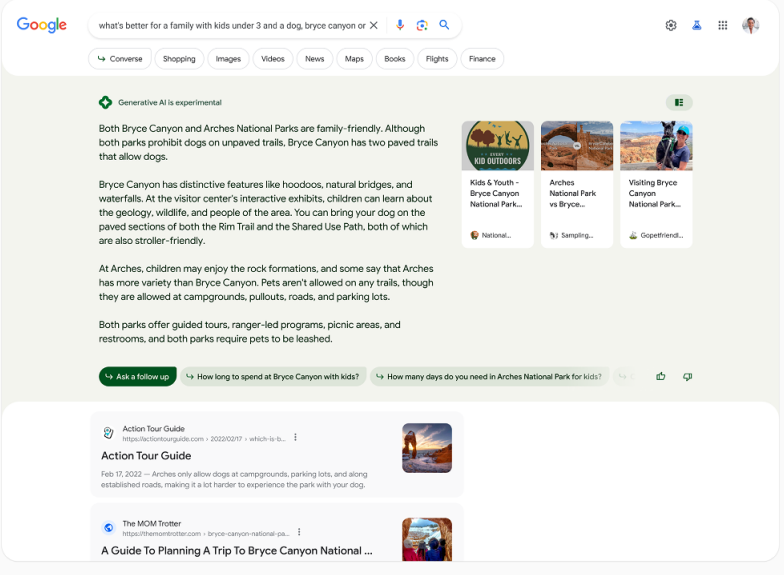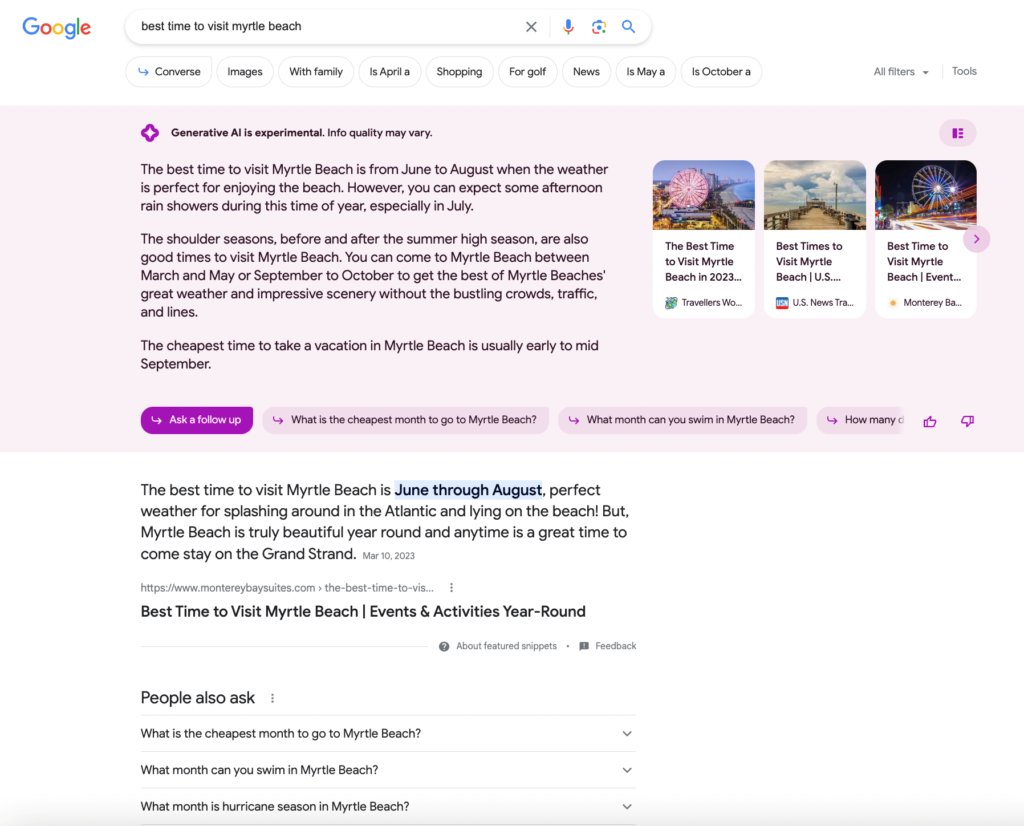In this article, we will dig into what SEOs need to know about the transition into AI-generated answers, what still holds for site owners, and how they can retain their real estate on SERPs.
An Overview of Search Generative Experience (SGE)
SGE brings the power of AI into Google Search.
According to Google, SGE is an early step in transforming the search experience with generative AI. The AI generates a snapshot with a brief overview or direct answer to the search query with additional links to resource sites to dig deeper.
These snapshots are like featured snippets on SERPs.

Google tags these snapshots as “a jumping-off point from which people can explore a wide range of content and perspectives on the web.” The resources displayed for in-depth exploration on the snapshots are pages whose content meets the E-E-A-T guidelines — that is, helpful, reliable, people-first content.
SGE also allows users to explore further through its “ask a follow up” tab, where users can input further queries or click on any suggested questions below the snapshot. The snapshots are powered by robust Large Language Models (LLM), including the advanced Multitask Unified Model (MUM) and PALM2 version.
SGE will not generate snapshots for sensitive queries that require authoritative and verifiable information. These search terms are Your Money or Your Life (YMYL) topics such as health, finance, or civic information.
Search-Generative Experience is in its early stage as Google is mindful of its limitations and making necessary progress based on feedback from its few users. It’s accessible via Search Labs in the United States only.
How Google’s Generative AI Improves Search Experience
Let’s dig deeper into some of the positive SERP changes we should expect as SGE rolls out.
1. Quick Access to Answers
“With Google’s AI, users can quickly find those surface-level answers to curiosity-based questions without sorting through 3000-word long, generic posts,” explains James De Roche, Founder at Lead Comet.
2. Semantic Understanding
Google’s AI doesn’t rely solely on keyword matching. It understands the semantic meaning of content, improving the relevancy of results.
Rather than relying solely on keywords and historical data, Google’s AI now utilizes neural networks to generate responses and search results more creatively, even for complex and idiosyncratic queries, explains Daniel Chabert, CEO of Purplefire. So, when someone searches, they don’t need to tailor their terms to get the right results. Google’s AI can parse beyond the actual words and phrases to understand context and intent. This allows it to return more nuanced results.
For example, Matt Diggity searched for “Compare two lunch spots near me that are good for groups” and got the following result.
3. Conversational Mode Implementation
SGE transforms the search experience into chatting with a friend. After getting a response for an initial search query, you can click the “ask a follow-up” tab or click one of the auto-generated questions to have a contextual conversation with the AI and get more information about your query.
For example, a user who searches “What’s better for a family with kids under three and a dog, Bryce Canyon or Arches” can ask follow-up questions like how long to spend at the park.
Google’s AI Overviews captures the context in the first search query—just like you’re chatting with a human—and uses it to provide relevant answers throughout the conversation.
Crucial Facts Every SEO Consultant Should Know About the SGE Transition
Here’s what you should keep in mind as you prepare for an AI-powered search experience.
1. Links Remain Relevant
Links have always been important for organic search performance, and Google isn’t changing that. But they’ll play a slightly different role in SGE.
After providing snapshots of answers for search queries, SGE will include links to original resources where users can find detailed information to understand better the results provided. Since SGE results will appear first on the SERPS, these linked pages will receive a chunk of organic traffic for relevant queries.
While there’s no hack to appear in the SGE snapshots, you can do a few things to increase your chances:
- Use schema markup to highlight important content elements such as product listings, titles, and images.
- Provide short, direct, easy-to-understand answers to questions before diving into any additional information. Let’s say someone asks, “What is seo?” Don’t discuss the history of SEO without defining SEO first.
- Optimize your web pages’ user experience. Break up walls of text with paragraphs, bullet points, and relevant visuals.
- Provide original, expert-focused content.
Google’s Helpful Content Update has more tips for creating high-quality content that ranks high in the SERPs.
2. Long-Tail Keywords to Match Context-Heavy Queries
As mentioned earlier, SGE shifts the focus from keyword matching to semantic searches. It understands context at a near-human level and can answer long-winded contextual questions.
This allows users to search naturally — just like asking a friend questions. For example, instead of “Bryce Canyon vs. Arches National Park,” one can search for “What’s better for a family with kids under three and a dog, Bryce Canyon or Arches National Park?” The second query is context-heavy and much longer than the first.
To win in the SGE era, SEOs must naturally incorporate long-tail keywords into their content and provide high-quality information that satisfies search intent — the type of information users expect to find when searching for a specific query.
3. Entity SEO Has Gained Dominance
Entity SEO, also known as entity-based SEO or semantic SEO, is an advanced search engine optimization (SEO) approach that focuses on understanding and optimizing for entities rather than just keywords.
In this context, an entity refers to a distinct, specific thing or concept, such as a person, place, organization, product, or other identifiable object or idea. Entities can be represented by words, phrases, or even structured data on web pages.
Through its Language Learning Models, Google’s AI can understand search entities and their context for better results. So, users don’t need to include some words in their search queries before Google knows what they are looking for and provides accurate results.
Learn more: How to Use Entity SEO to Rank Higher – A Definitive Guide
4. There Will Be A Drop In Organic CTR
AI snapshots will appear first on the SERP, even before featured snippets.
This increases the click-through rate competition of an overly competitive SERP. SGE results and the linked pages will capture much of the organic traffic and reduce the organic click-through rate for other ranking pages.
So, how can SEOs prepare for this? Two ways:
- Optimize your content based on the Helpful Content Update recommendations to increase your chances of showing up as one of SGE’s linked pages.
- Create authoritative content on niche and complex topics. While extensive, there are still data voids or information gaps in SGE’s database. When users search for such topics, SGE will not provide AI answers. Instead, it will rank expert-led content.
What’s the Sigh of Relief?
We won’t deny that the era of generative AI will affect website organic traffic, but Google won’t stop feeding sites with organic traffic.
Here’s why:
- Google’s AI needs website content to provide users with relevant, up-to-date information.
- People value human-first content over AI-generated answers. In the unveiling of Search Generative Experience, Cathy Edwards, VP of Engineering at Google, said, “Even in the world where AI can provide insights, we know that people will always value other people’s input, and a thriving web is essential to that.”
- Google generates $162.45 billion from search ads, equivalent to 58.1% of its annual revenue, and $32.78 billion from network ads, equal to 11.7% of its yearly income. If websites stop receiving traffic, site owners will stop bidding on these ads, and Google will lose money.
SEO Strategies to Stay Relevant in the World of Generative AI
Search Generative AI has ushered in a new era of possibilities, transforming content consumption. But you can stay ahead of the curve by:
1. Creating People-First Content
SGE doesn’t change Google’s commitment to helpful, people-first content. Instead, it reinforces it. In their words, “SGE is rooted in the foundations of Search, so it will continue to connect people to the richness and vibrancy of content on the web and strive for the highest bar for information quality.”
Google’s generative AI will help users speed up search by providing quick answers to contextual questions and linking to high-quality pages where they can find more information for a better search experience.
Creating people-first content, that is, content that matches search intent with user-friendly, relevant, and up-to-date information, is how you win in an SGE world. Before publishing a new piece of content, ask yourself these six questions:
- Do you have an existing or intended audience for your business or site that would find the content useful if they came directly to you?
- Does your content demonstrate first-hand expertise and a depth of knowledge (for example, expertise from having used a product or service or visiting a place)?
- Does your site have a primary purpose or focus?
- After reading your content, will someone leave feeling they’ve learned enough about a topic to help achieve their goal?
- Will someone reading your content leave feeling like they’ve had a satisfying experience?
- Are you considering our guidance for core updates and product reviews in mind?
Also Read:
What is search intent? Intent targeting keyword examples
2. Build A Strong Backlink Profile
Backlinks are not going anywhere. With everyone competing for real estate on SGE-powered SERPs, high-quality backlinks can boost your site’s authority and increase your chances of showing up in the AI snapshots.
Here are some steps to help you build a strong backlink profile:
- Guest Blogging: Reach out to other websites in your niche and offer to write guest posts. In exchange, you can include a link to your site in your author bio or within the content, provided it adds value to the reader.
- Broken Link Building: Find websites with broken or outdated links related to your content. Contact the website owner, inform them of the broken link, and suggest your content as a replacement. This can be a win-win situation.
- Content Promotion: Promote your content through various channels, including social media, email newsletters, and online communities. The more exposure your content gets, the more likely it attracts natural backlinks.
3. Provide A Better User Experience
This is one of the primary reasons Google introduced SGE. They want their users to have the answers to their queries within the shortest time.
Don’t bore your readers with a wall of text all in the name of reaching a word count. Ancient SEO theory believed that Google loved it when you take your readers through a long route before providing the answer to their search query.
Include a direct answer to the search query quickly in your content, especially as paragraph snippets if it’s a straightforward question.
There’s a high chance your paragraph snippet can be the AI snapshot for that search query.
Stay on Top of SERP Changes
Search isn’t just about blue links anymore. With AI Overviews and LLMs changing how people discover information, it’s getting harder to know where your content actually shows up.
That’s where Keyword.com comes in. Alongside our free keyword position checker and traditional rank tracking, you can also track how your pages appear in AI-generated results—from Google’s SGE to Perplexity and beyond. It’s one dashboard for all your visibility.
Whether you’re running client reports or keeping tabs on your own site, having the full picture means you can adjust faster, spot opportunities sooner, and stay ahead.
Start your 14-day free trial and see what kind of visibility you’re really getting.



